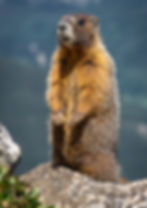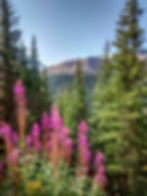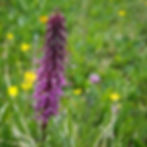Indian Peaks Wilderness Alliance
Preserving and Protecting the Indian Peaks and James Peak Wilderness Areas
Ecology, Flora & Fauna
Ecological Overview
Ecologists breakdown ecosystems into "life zones" to describe areas with similar plant and animal communities that vary by elevation and climate.
The Indian Peaks and James Peak Wilderness areas span the elevation range from 8,400 to over 13,500 feet, which includes Montane, Sub-Alpine, and Alpine life zones, as well as the Riparian life zone which occurs along stream, rivers, ponds, wetlands and lakes.

Colorado Life Zones Diagram (from Shelledy K-12)

Colorado Life Zones Diagram (from Shelledy K-12)
The Montane Life Zone (8,000 - 10,000 ft. elevation) has the richest diversity of plant and animal life. This zone is the starting point for most trails in the IP/JP wilderness areas and is dominated by aspen and evergreen forests, including Lodgepole and Ponderosa pines, Douglas fir and some Engelmann spruce.
Along riparian areas, water-loving trees are found including willows, mountain alder, water birch.
The Subalpine Life Zone (10,000 - 11,500 ft.) sits just below the tree-line and includes forests dominated by Subalpine Fir, Englemann Spruce and Limber Pine. These species grow tall and straight at lower elevations but can become shorter and grow into unusual shapes in the harsh conditions closer to treeline - such as stunted and gnarled stands of trees are known as krummholz.
The Alpine Life Zone (11,500 ft. and above) is the "land above the trees" characterized by alpine tundra plant life such as grasses and sedges, lichens and dwarf-sized flowering plants. To see a list of species in the alpine life zone that have been catalogued at the Mountain Research Station at Niwot Ridge, click here.
Wildlife Interactions
The Indian Peaks and James Peak Wilderness areas are home to some amazing wildlife, including moose, black bears and mountain lions. Wild animals are unpredictable and can be dangerous when they feel cornered or threatened, so keep a respectful distance and keep your dog on a leash (its the law anyways)! Predators like bears, lions and coyotes can be dangerous when they become acclimated to human food or garbage, or when unattended small children or pets present easy prey.
In the last few years, the Indian Peaks Wilderness has been experiencing a significant increase in bear encounters - particularly at the Diamond Lake, Jasper, and Woodland Lake backcountry zones. The bears are associating the camp areas with food and are not fearful of humans. If you are camping in these areas there is a high likelihood you will encounter a bear. If you are uncomfortable, then don't camp in these areas! If you decide to camp, you should bring a bear proof canister for food storage or properly hang your food.
Moose were introduced into the state in the 1970s and are now frequently seen in the IP/JP wilderness areas and moose encounters have increased statewide. They may look like gentle giants, but they are actually some of the most dangerous creatures you can encounter in the wild. Moose cows with their calves can become very aggressive when they feel threatened and have been known to chase and maul people and dogs (whom they view as wolves, their natural predators). Keep a safe distance and never get between a moose cow and her young.
Since 2013, Colorado Parks and Wildlife is aware of at least 15 moose conflicts resulting in minor to serious human injuries. In all but two occurrences, dogs elicited the initial response from the moose. Hikers have been seriously injured after their off-leash dog ran back to them after being chased by an aggressive moose. Remember, dogs must be kept on a leash at all times which can help prevent your dog from being attacked or chased by other animals. See Dogs in the Wilderness for more tips on how to keep your pet safe in the wild.
Visit the Colorado Parks and Wildlife - Living with Wildlife page for more videos and tips on avoiding wildlife conflicts. Also check out the following brochures:
Flora & Fauna
The IP/JP wilderness areas are home to a rich diversity of flora and fauna (plants and animals) including: over 900 species of plants, 280 species of birds and 60 species of mammals, many inhabiting specific elevational life zones. To learn more about the animals & plants found in the area, visit the Rocky Mountain National Park Nature page. Check out our Recommended Reading page for recommended field guides and apps.
Animals
The IP/JP wilderness areas are home to a rich biodiversity of animal life, including many species of mammals, birds, amphibians, reptiles, fish and all kinds of butterflies and other insects. The wilderness provides important habitat for species found only at high elevations, as well as corridors for mammals traversing the area and migrating birds and pollinators.
Below are some of the iconic species found in the area:

Pika are small mammals of the alpine tundra, also called "conies" or "rock rabbits". They are very vocal making a high pitched "eek" to mark territory and warn of predators. They do not hibernate so they spend the summer gathering "hay piles" of vegetation to eat through the winter. (Photo by IPWA volunteer Gary Daer, winner of 2017 photo contest)

There are several species of chipmunks and squirrels in the IP/JP wilderness areas, including the Least Chipmunk, the Golden Mantled Ground Squirrel, the Chickaree/Pine Squirrel, and the Abert's Squirrel. (Photo by IPWA volunteer Scott Oetting, winner of 2017 photo contest)

The White-Tailed Ptarmigan is the only year-round native bird of the Colorado alpine ecosystem. This small grouse prefer walking over flight and nests on the ground in alpine habitats at or above treeline. The Ptarmigan's natural camouflage gives it an amazing ability to blend into the rocky surroundings, with seasonal plumage changes from summer brown to white in the winter. (Photo by IPWA volunteer Kelly Prendergast, winner of 2017 photo contest)

The yellow-bellied marmot is one of the largest members of the squirrel family. They live in colonies with elaborate burrows underneath alpine meadows and rock fields. During summer months they fatten up eating grasses, flowers, insects and birds' eggs. One marmot will stand sentinel and whistle to warn others of predators. During the winter months, they hibernate in their burrows. (Photo by IPWA volunteer Bill Bowman, winner of the 2018 Photo Contest)

The red fox has the widest range of any carnivore, found on almost every continent and in diverse habitats from deserts to mountains. They are believed to mate for life, often returning to the same dens generation after generation. (Photo by Clear Creek County)

The IP/JP Wilderness areas have over 50 alpine lakes, many stocked for fishing. 33 lakes have naturally reproducing trout populations and a few remote lakes are home to native species, including the endangered Greenback Cutthroat Trout. (Photo by NPS)

Mountain lions, also known as pumas, cougars, or panthers, are powerful large and elusive predators. Download the brochure on mountain lion safety tips! (Photo by USFS)

Boreal toads were once common in the Southern Rocky Mountains from 7,000 - 12,000 ft elevation, but are now listed as endangered in Colorado. Like many amphibians worldwide, they have declined over the past several decades. Factors in their decline include habitat loss, climate change, and the chytrid fungus. They are about four inches long with warty, brown-speckled skin. IPWA has funded research on this species as part of the 2019 grant program. (Photo by NPS)

Black bears live in the IP/JP wilderness areas, hibernating in winter and emerging in spring , sometimes with cubs born in the den. Bears are omnivores eating mostly plants, roots, berries, nuts and insects. Bears can become dangerous when habituated to human food and garbage, so food should stored in a bear proof container or hung in a tree while camping. Download the brochure on hiking in bear country! (Photo by NPS - Ann Schonlau)

Several species of hummingbirds migrate through the IP/JP wilderness during summer months (from late April to early September). Hummingbirds favor red blossoms with a tubular shape, but they also feed on pink, orange, peach and purple flowers. (Photo by National Audubon Society)

Colorado boasts the largest elk herds in North America and elk can be seen migrating through the IP/JP wilderness. Elk are one of the largest members of the deer family and live in large social herds. Large animals like this Elk live and are sustained by the habitat Wilderness provides. And while Wilderness is a refuge for many animal species, it is also a humans refuge where we can experience nature is its most basic and wild state. (Photo by IPWA volunteer Kelly Prendergast)

Coyotes are a smaller relative of the gray wolf, which was extirpated from the state in the 1900s. Coyotes can be very vocal at dawn and dusk, howling, barking and yipping. They travel alone or in pairs and sometimes form hunting packs. (Photo by NPS)

The snowshoe hare has large hind feet that act like snowshoes as well as thick fur on their feet for insulation and traction. They have seasonal coloration changing from brown in the summer to white in the winter to aid in camouflage. (Photo by Massachusetts Audubon Society)

Gray Jays, also known as "camp robbers" can be very vocal and have been known to boldly follow campers and hikers and steal food. They live in evergreen-deciduous forests across North America, where they do not migrate but may move down to lower elevations in winter. (Photo by NPS - Ann Schonlau)

The IP/JP wilderness areas provide seasonal and year round habitat for various birds of prey, including eagles, hawks, ospreys, falcons, kestrels, and owls. (Photo by IPWA volunteer Mary White, winner of 2017 photo contest)

Moose were introduced to Colorado in the 1970s (prior to then only a few transient moose would wander into northern Colorado). Moose populations now number over 3,000 in the state, with many seen in the IP/JP wilderness areas. (Photo by IPWA volunteer Reinhard Hohensee, winner of 2015 photo contest)
Wildflowers
Many visitors come to the IP/JP wilderness in the summer months to see alpine meadows teeming with colorful wildflowers. The wildflower season begins as early as April and peaks June - August, with flowers blooming later in the season at higher elevations. With hundreds of species, we've chosen to note just a few of our favorites below:

This alpine plant has bright yellow saucer shaped flowers and dark green leaves. In August the leaves turn brilliant red, covering the tundra in swaths of color. Alpine avens is the favorite food of pikas, who gather and dry this plant for winter consumption. (Photo by IPWA volunteer James Scott, a 2018 Photo Contest Winner)

The iconic Colorado Columbine is the state flower - blue petals represents the sky, white represents snow and yellow symbolizes Colorado's gold mining history. (Photo by IPWA volunteer Jessica Ansari, a 2015 Photo Contest Winner)

Common Fireweed has bright pinkish-purple flowers on tall stems that can reach 4 ft high. It gets its name from being one of the first plants to return after a wildfire. (Photo by IPWA volunteer Carol Dozier, 2016 photo contest winner)

Heartleaf Arnica grows in dry montane and subalpine forests and meadows. Each flower has 10-16 rays surrounding a darker yellow head. (Photo by IPWA volunteer Yonah Cohen)

Indian Paintbrush has modified leaves called bracts that display the beautiful shades of brilliant red, rosy pink, purple, and yellow (the actual flowers are green tubes hidden by the colorful bracts). (Photo by IPWA volunteer Yonah Cohen)

A tall flowering plant with clusters of bell-shaped flowers. The buds change from pink-lavender to blue to alert bees when the flowers are ready for pollination. (Photo by NPS - D. Biddle)

White Marsh Marigolds have glossy dark leaves, white flowers with a yellow center. One of the earliest to bloom in spring, they can be found along the edges of sub-alpine wetlands and meadows after snowmelt. (Photo by IPWA volunteer Yonah Cohen)

With fuzzy crocus-like flowers, it is one of the first signs of spring. (Photo from NPS by A. Schonlau and insert by D. Biddle)

The tall purple stalks in the front are Elephantella, also known as Elephant's head, is named for its purple flowers which resemble an upturned elephant trunk and ears. (Photo by IPWA volunteer Yonah Cohen)

Found in montane forests and meadows, the Fremont Geranium has pink flowers with dark purple veins that serve as "runways" to direct pollinators to the flower center. (Photo by IPWA volunteer Yonah Cohen)

Parry Primrose blooms after the snow melts in wet areas and along stream banks with bright pink flower clusters. (Photo by IPWA volunteer Yonah Cohen)

Bistort prefers moist mountain meadows and alpine tundra. Nicknamed "miners socks" for its pungent smell, each stem bears a cluster of tiny white flowers. (Photo by IPWA volunteer Yonah Cohen)



